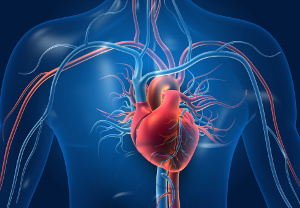Heart patients are often low in iron
 Iron is essential for oxygen transport in the blood and cellular energy production, yet deficiencies are common in patients with chronic heart failure. This additionally impairs their physical capacity and quality of life. Iron deficiency is associated with hospitalization and early death, as highlighted in a review article published by the American College of Cardiology. Heart failure patients should therefore always have their iron status checked. Intravenous iron therapy appears to be most effective for treating iron deficiency in heart failure patients. It is also crucial for these patients to ensure adequate dietary iron intake while being mindful of factors that can limit iron absorption and utilization.
Iron is essential for oxygen transport in the blood and cellular energy production, yet deficiencies are common in patients with chronic heart failure. This additionally impairs their physical capacity and quality of life. Iron deficiency is associated with hospitalization and early death, as highlighted in a review article published by the American College of Cardiology. Heart failure patients should therefore always have their iron status checked. Intravenous iron therapy appears to be most effective for treating iron deficiency in heart failure patients. It is also crucial for these patients to ensure adequate dietary iron intake while being mindful of factors that can limit iron absorption and utilization.
Iron is an essential nutrient with a primary function in the oxygen-transporting hemoglobin of red blood cells. After being absorbed by cells, the iron is used in the mitochondrial energy turnover. Iron is also vital for many enzymes, DNA synthesis, immune defense, skin, hair, and nails. It’s possible to be iron deficient without having anemia. The heart beats approximately 100,000 times a day, making it highly dependent on energy. It has been reported that more than 50 percent of patients with chronic heart failure suffer from iron deficiency, and the number is presumably even higher among those with acute heart failure.
The New York Heart Association (NYHA) has categorized heart failure into four classes (NYHA classes 1-4), all depending on symptoms such as shortness of breath, pain, and heart palpitations. Class I patients are only slightly affected by their condition, while Class 4 patients are bedridden. It appears that iron deficiency is more widespread among patients in the higher NYHA classes. Despite this, iron deficiency is still underdiagnosed and undertreated among patients with chronic heart failure.
The big question that still remains is how best to treat iron deficiency in these patients because chronic heart failure is linked to systemic inflammation in the body, and that can disturb the body’s ability to regulate its iron reserves.
Treating iron deficiency in heart failure
It goes without saying that heart failure patients require fast and effective treatment for their iron deficiency. However, regular oral iron supplements are often ineffective due to poor absorption and side effects. What is more, such iron supplements can interfere with the inflammation that is often seen. The reason for this is that iron catalyzes free radicals.
The new review article mentions that intravenous iron therapy using iron sucrose or ferric carboxymaltose is far more effective, as it loads much more iron into the blood with one dose only.
The authors reference the FARI-HF study, one of the first to include iron-deficient heart failure patients. In this study of 459 NYHA class 2-3 patients, one group received 200 mg of intravenous ferric carboxymaltose per week during the initial phase. During the second phase, the same patients got 200 mg of intravenous ferric carboxymaltose per month. The other group got placebo during the same periods. In this study, 50 percent of the patients in the treatment group showed signs of improved iron status, whereas only 28 percent in the placebo group had higher iron status, regardless of whether or not they had anemia. Other studies show that intravenous iron therapy can lower the rate of hospitalization among heart failure patients. Also, it seems that certain subgroups with ischemic heart disease also benefit more from intravenous iron therapy.
Conclusion and long-term management
Patients with heart failure and iron deficiency have reduced quality of life and an increased disease risk and risk of early death. Besides conventional medical therapies for heart failure, intravenous iron therapy has a potential for reducing symptoms and hospitalization risk in many patients.
It is generally recommended to try to get enough dietary iron and pay attention to things the can limit the body’s uptake and utilization of iron.
Iron sources, requirements, and absorption
The daily iron requirement is normally around 9-15 mg.
Some of the good iron sources are liver, meat, eggs, red beet, pumpkin seeds, wholegrains, leafy greens, lentils, and apricots. Heme-iron that is only found in animal foods has the best absorption. Vitamin C enhances the absorption of iron in the body.
Low stomach acid, antacids, and excessive intake of calcium from dairy products and supplements inhibit the body’s iron uptake. Prolonged use of acetylsalicylic acid, NSAID preparations, tetracycline, disulfiram, and alendronate can also affect the iron uptake. If you take regular iron supplements, you should take them 3-4 hours apart from any calcium supplements and the aforementioned medications.
The body’s iron balance is regulated by peptide hormones (hepcidin) that is produced in the liver so poor liver function can also affect the body’s iron status. Non-alcoholic fatty liver disease (NAFLD) and being overweight are also quite common and are seen in connection with metabolic syndrome, which is the precursor of diabetes. Chronic inflammation also plays a role in the body’s iron balance, so it is a good idea to stick with an anti-inflammatory diet that is even good for cardiovascular health and weight control.
Heart failure patients should also think of Q10
Multiple studies show that heart failure patients typically lack Q10, which is an essential coenzyme involved in cellular energy turnover. It is also a powerful antioxidant that protects the heart from oxidative stress. The Q-Symbio study of 420 heart failure patients showed that daily supplementation with pharmaceutical-grade Q10 (3 x 100 mg) for two years increased cardiac strength and lowered heart failure-related mortality by 43 percent compared with placebo.
References:
Elena M. Donald. Focus on Heart Failure I Ironclad: The Treatment of Iron Deficiency in Heart Failure. American College of Cardiology. 2024
Àlvaro Gonzalez-Dominguez et al. Iron Metabolism in Obesity Syndrome. International Journal of Molecular Sciences. 2020
TIP! See also the related articles
Search for more information...
- Created on .








